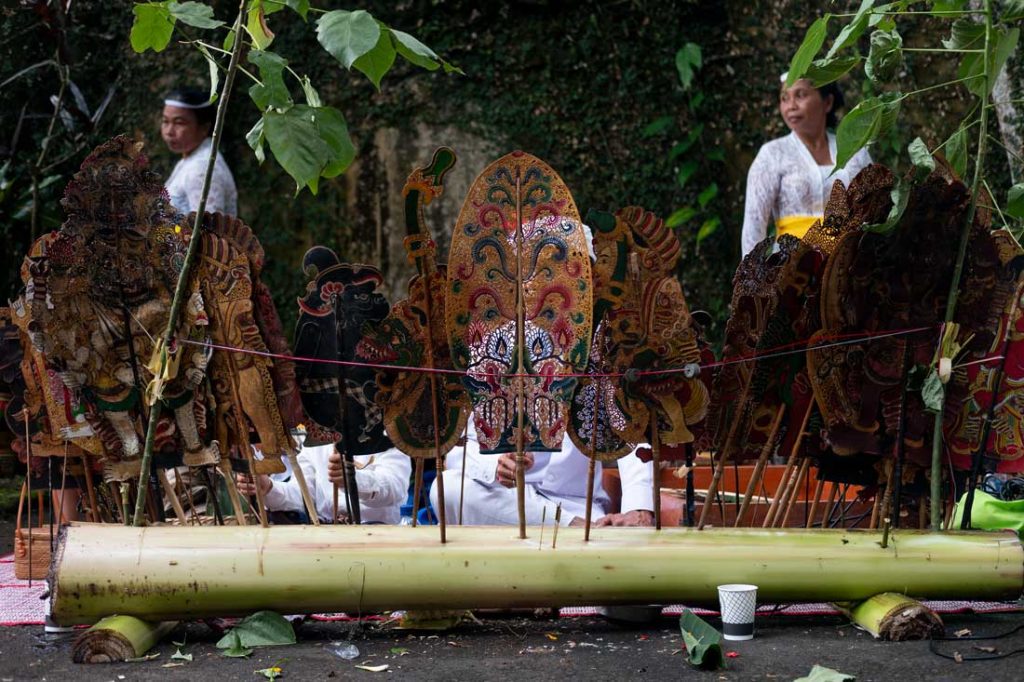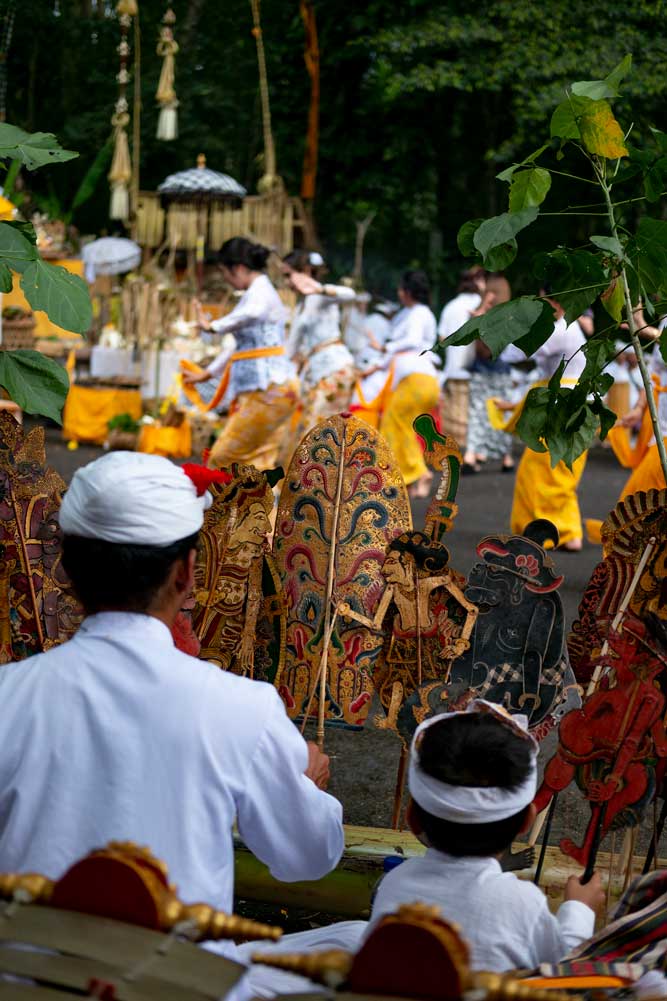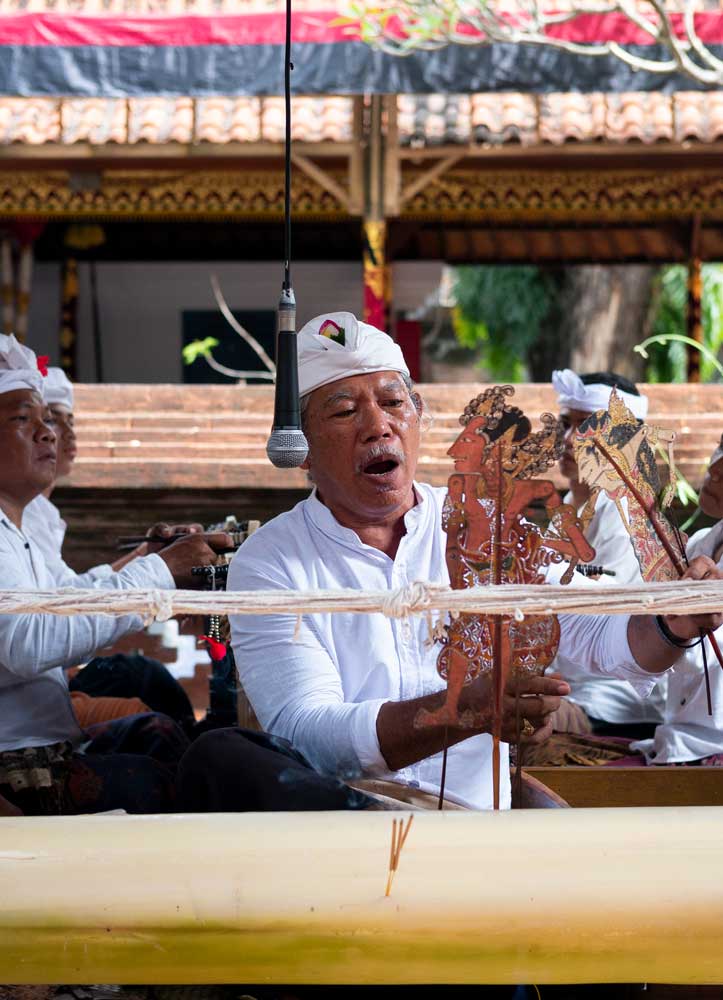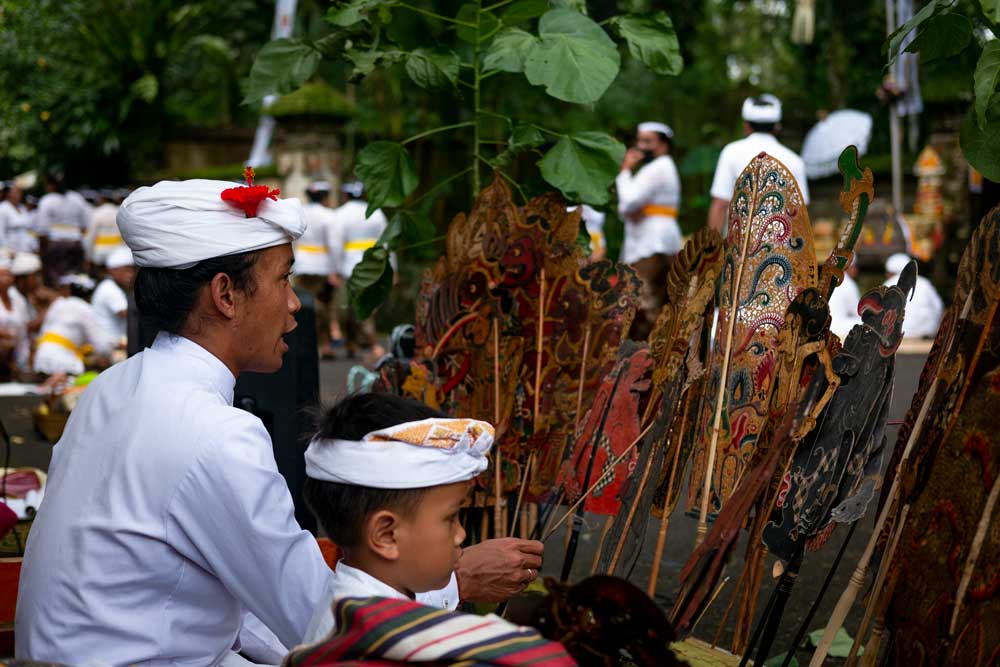
If there is an Indonesian form of art that is of international repute and calls to mind the notion of a “magic show”, this is undoubtedly the shadow play or puppet show theatre: the “wayang”.
The trembling shadows of ancestral figures dancing on a white screen as they are shaped and unshaped by a flickering lamp. They tell the stories of yore: the struggle of the 5 Pandawas of the Mahabharata as they try to recover their kingdom, or Prince Rama’s yearning for his kidnapped Sinta. And performing is the true magician, the dalang, singing in Old-Javanese, joking in low and high-Balinese, and deftly manipulating, as he sweats under the heat of the oil lamp, heroes and villains, gods and giants. Intermediary of and to the gods, he is the “priest” par excellence (amangku dalang), the teacher, the one through which all Balinese, prior to colonisation, learned myths, religious philosophy and rules of ethical behavior. His art encapsulates the whole of Balinese teachings. It provided the schooling of the days before modern schooling.
Everything in a wayang performance is imbued with symbolic meaning. God is compared to the “Sang Hyang Ringgit” — the Great Puppet Master — and the earthly dalang is his intermediary. The screen stretched across four bamboo sticks on which he performs symbolises the world (jagat raya), while the banana stem on which he sticks his puppets at the foot of the screen is our Mother Earth (Pertiwi). The oil lamp is the godly source of cosmic energy, which gives life to all living beings. Sitting cross-legged in the middle to play in front of the screen – thus enabling the shadows to be seen on the other side, the dalang literally plays the cosmic struggle between the forces of “good” (or conservation) and “bad” (or destruction) at work in the world. Those forces are represented by the puppets that make their entrance respectively from the dalang’s right and left. This cosmo-religious function is of utmost importance; entertainment is only a secondary. The wayang show never begins without a long litany in Old-Javanese, begun with a call to Sang Hyang Ringgit to come down and literally inhabit the then demiurge dalang.


Wayang performances are held on the occasion of ritual events, when the niskala (intangible) world comes to life and cosmic balance is at play. The stories change according to the event that is being celebrated: wedding, post-cremation ceremony, vows etc, the mythical heroes playing episodes in which corresponding stories of love, of the holding of a big festival or of the death of a hero is the main topic. The heroes and villains address one another, never the spectators; they speak in Old-Javanese, and their speech is translated in Balinese by the ‘buffoons’. This layering of speech, story-telling further reinforces the sacrality of the show, which only now and then lapses into buffoonery.
Considering this key role of the wayang, it is no surprise that it finds itself attributed a whole week in the Balinese 210-day calendar of 30 seven-day weeks, which determines –together with the moon cycles of the Saka year — most of the rites of Balinese religion.
Every 35 days, on the crossing of the Saturday of the 7-day week and the Kliwon of the 5-day week, recurs the ‘Tumpek’ ritual days, in which an important aspect of Balinese life is celebrated at the end of the corresponding week. There are 6 Tumpeks: addressed respectively to weapons (Tumpek Landep, 2nd week), plants (Tumpek Uduh, 7th week), ancestors (Tumpek Kuningan, 12th week), music (Tumpek Krulut, 17th week), animals (Tumpek Kandang, 22nd), and wayang (Tumpek Wayang, 27th week).
The Tumpek Wayang, which comes on the closing of the Wayang week, is considered the birthday of the wayang. The dalang makes offerings to his set of puppets and especially to the most sacred ones: the godly buffoons (Delem and Sangut, respectively from the positive and negative sides). He usually has a shrine in his family temple through which he addresses the “spirit” of his talent, or taksu, that inhabits him during his performances, and through which he gets in communication with the forces from the intangible world. Villagers may also visit the dalangs to ask for the holy water produced by sacred performances.

Yet, the peculiarity of the wayang week, and of the Tumpek wayang, is also that it unleashes destructive cosmic forces which the Balinenese have to ward off. The story goes that Shiva’s demonic son, Batara Kala – the Lord of Time — goes on a rampage during this week, and children born during the wayang week have to be protected by a cleansing ceremony.
The origin of this ritual is mythological. It goes back, so goes the story, to the birth of Batara Kala from a drop of semen fallen into the sea after his father was repelled by his wife Uma. As Shiva feared the consequences for the world of the bad temper of his demonic son, he asked him to cut his canines and thus control his demonic temper.
Kala accepted, but on one condition: that he may devour those children born like him on Tumpek Wayang. Shiva accepted. Alas, fate had it decided that Shiva’s wife was to give birth to another son born on Tumpek Wayang: Dewa Rare Kumara – the god protector of children. When he heard about it, Kala claimed his due. He should be allowed to eat his brother. Shiva and Uma begged him to differ it, because Kumara was still a baby. But after he had grown up, there was nothing they could do to prevent their demonic son to go after his prey. But before he could be caught, Dewa Rare Kumara had fled and taken refuge among humans. Furious, Batara Kala, pursued him all over the middle-world, wreaking havoc all along. He was on the verge of catching him, when his brother hid in a gamelan, just as the shadow master was performing a cleasing ritual. Batara Kala saw offerings there, and hungry, carelessly swallowed them. But he now had eaten what was not his by fiat of the gods. The dalang was furious and asked for a pay-back: ashamed, the demonic god accepted to give up trying to devour his brother.
Since those days of yore, Dewa Rare Kumara is the protector of the children. Kala – the Balinese Chronos – is still the “devouring” Lord of time and of people, especially children, but he only devours those who are not respectful of ritual requirements. He is at his most dangerous during the “joints” (sandi) of the day: dawn, midday and sunset. He is also a danger to all those born during the wayang week. To ward off this danger, people who have a child born on this week usually make the vow to hold a Sapuleger wayang performance, which tells the story of Kala depicted above and thus cleanse (ngruwat) the child of all danger.
The Tumpek Wayang ceremony, and the related story of Batara Kala reminds us that to the Balinese, time is anything but neutral. It is heavily charged with positive and negative cosmic energy which the individual, as a microcosm himself/herself has to keep in balance with one another through proper ritual.









